#gabriel-ernest
Text

My current Ultrakill brainrot + my excitement over ep 7 of Murder drones = 👆
#ultrakill#murder drones#crossover#universe fusion#V1#v1 ultrakill#V2#v2 ultrakill#eldritch V2#Absolute solver#Robot body horror#It was harder to draw than I thought#it was also fun#The absolute solver when it relies that the ultrakill universe is missing a God: It's a free real state#This is my explanation for this madness#the inhabitant of hell are in for a treat#and by that I mean horrors beyond comprehension that may or may not have been man made#Yes I gave V2 blue wires. I like that look#The first time I draw Gabriel in ernest and of course it's this#kido art#doodles
123 notes
·
View notes
Text








Gattaca (1997)
Director - Andrew Niccol, Cinematography - Sławomir Idziak
"For someone who was never meant for this world, I must confess I'm suddenly having a hard time leaving it. Of course, they say every atom in our bodies was once part of a star. Maybe I'm not leaving... maybe I'm going home."
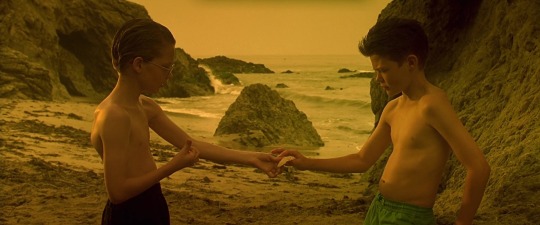
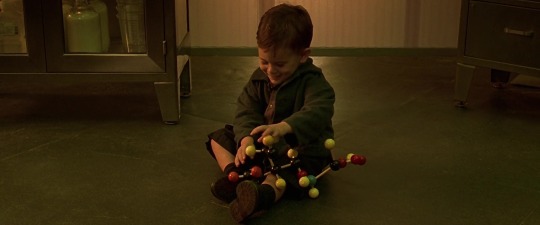
#scenesandscreens#gattaca#andrew niccol#tony shalhoub#alan arkin#dean norris#ken marino#gabrielle reece#Cynthia Martells#xander berkeley#Jayne Brook#elias koteas#maya rudolph#blair underwood#ernest borgnine#Mason Gamble#uma thurman#jude law#Loren Dean#William Lee Scott#gore vidal#ethan hawke
202 notes
·
View notes
Text
More images of 1912 fashion -
1912-1913 Afternoon dress.
1912 (Winter) Jeanne Paquin evening gown (Helen Larson Historic Fashion Collection, FIDM Museum - Los Angeles, California, USA).
1912 (Winter) Jeanne Paquin evening gown (Helen Larson Historic Fashion Collection, FIDM Museum - Los Angeles, California, USA).
Left 1912 Lucile dress (V&A). From omgthatdress.tumblr.com/post/654088327176306688/evening-dress-lucile-1912-the-victoria-albert 1280X1707.
Center and right ca. 1912 Chantilly lace dinner dress front quarter and back (location ?). From whitakerauction.smugmug.com-Fall2012-Clothing-ID-22-140-i-b3kCXfz 3068X2895


1912 Lady in Furs, Mrs. Charles A. Searles by Cilde Hassam (location ?). From tumblr.com/catherinedefrance 900X1090.

1912 Lady wearing a large hat sitting by Franz von Stuck (auctioned by Sotheby's). From their Web site 1753X1991.

1912 Mrs J., by Józef Męcina-Krzesz (location ?). From godsandfoolishgrandeur.blogspot.com/2016/11/randomly-ix.html; shadows 60% and fixed spots w Pshop 750X975.
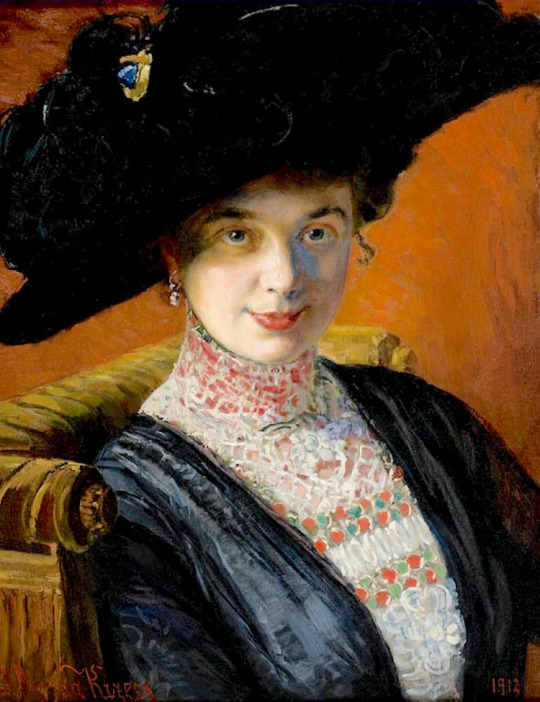
1912 Mrs. Ernest Guinness by Sir Francis Bernard Dicksee (auctioned by Christie's) From www.pinterest.com/nouvellegiselle/vintage-inspiration slightly cropped & fit to screen 924X1500.

1912 Mrs. John Lawrence by Edmund Tarbell (private collection). From cutlermiles.com/mrs-john-lawrence-edmund-tarbell/ 992X1280.
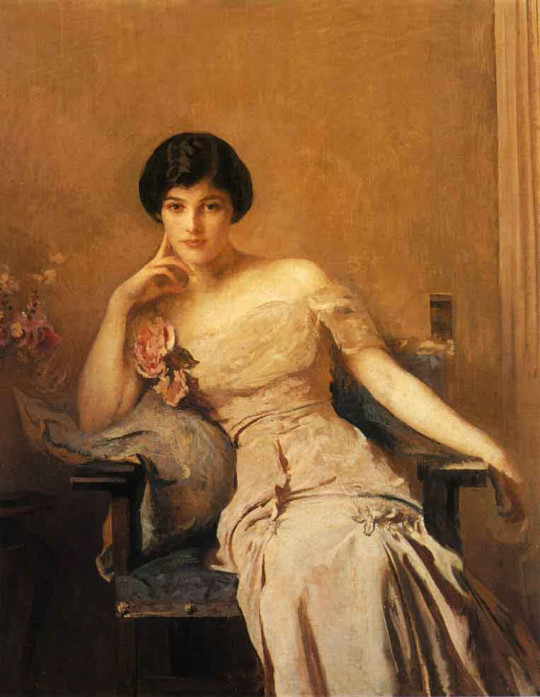
Left 1912 Princess Elena of Greece, nee Russia, in 1912, wearing the diamond and pearl tiara she later gave to her daughter as a wedding gift From pinterest.com/inara0798/aristocrats/ 602X960.
Center 1912 Princess Paley in a dinner dress with fancy headdress. From Sacheverelle's photostream on flickr 488X983.
Right 1912 Vizcondesa de Termens From laalacenadelasideas.blogspot.com/2012/12 1018X1316.


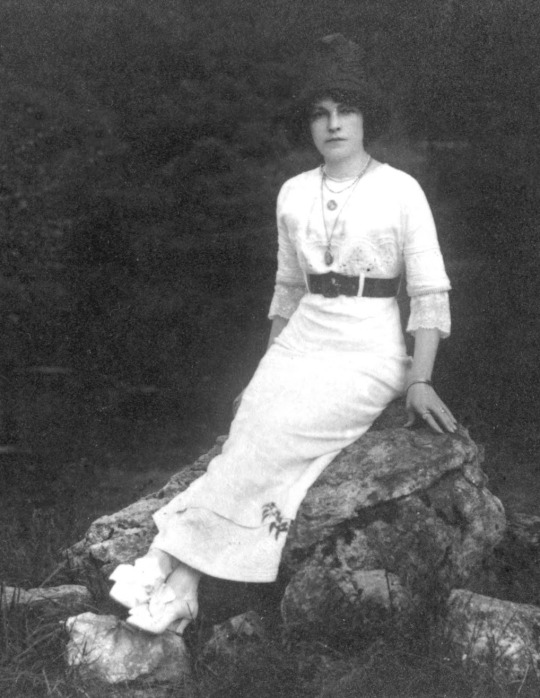
1912 Robe de Visite de Paquin (pl.5, La Gazette du Bon ton 1912-1913 n°2) by George Barbier. From edition-originale.com/en/prints-engravings-photographs/ 1682X2518.
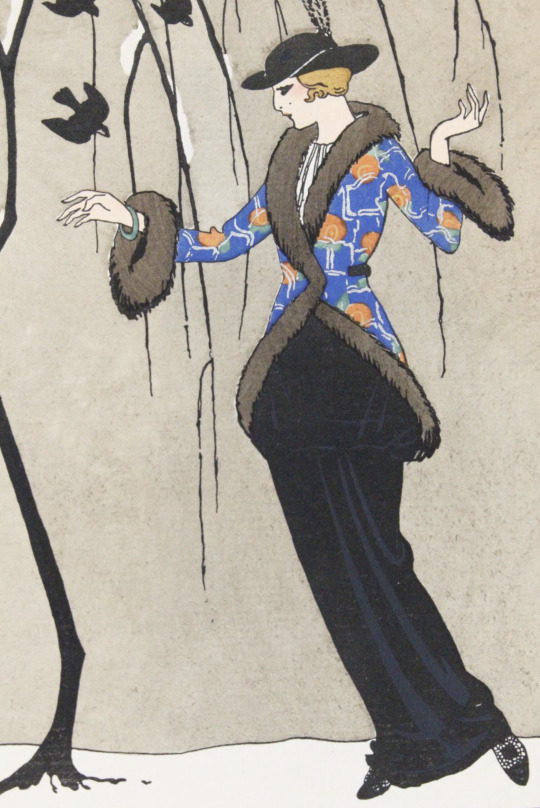
Left ca. 1912 Frau Prinzessin Rupprecht in Bayern, Marie Gabrielle in Bayern, by F. Grainer. From eBay fixed spots w Pshop 1017X1600.
Right ca. 1912-1913 Olga de Meyer wearing the famous Paul Poiret coat La Perse, photograph by Baron de Meyer. From facebook.com/144304418968266/photos/a.397639360301436/1143579645707400/?type=1&theater 1123X2048
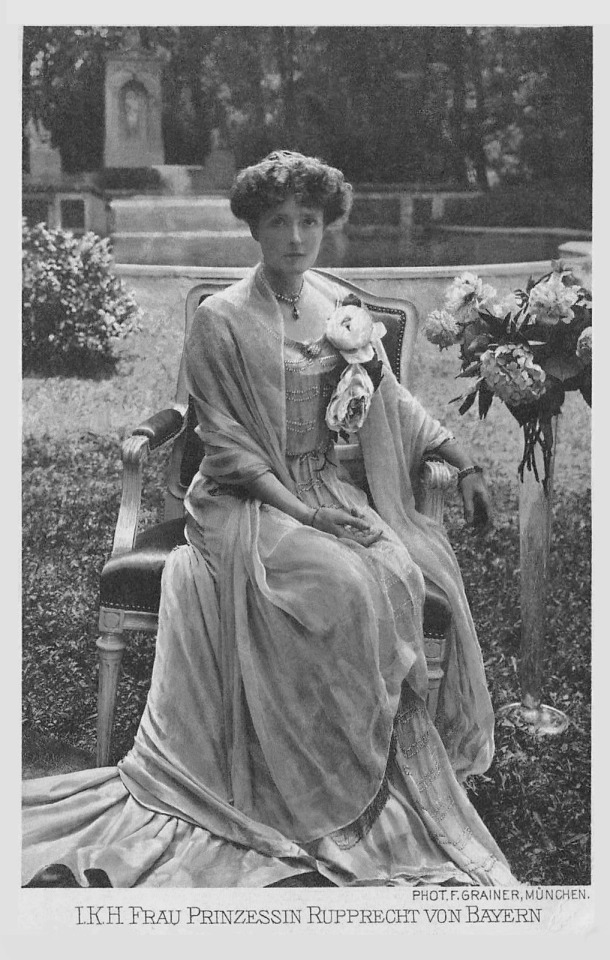

Left 1912 Winifred, Duchess of Portland by Philip Alexius de László (Portland College - Ravenshead, Nottinghamshire, UK). From books0977.tumblr.com/post/111045895147/the-duchess-of-portland-1912-philip-alexius-de 999X1280.
Right 1912 New Book by Walter Bonner Gash (location ?). From tumblr.com/larobeblanche/742427773413556224/the-new-book-c-1912? 876X1024.


Left 1912 Le Manteau bleu by Xavier Gosé (location ?). From tumblr.com/mote-historie/744587745354301440/painting-by-xavier-gos%C3%A9-le-manteau-bleu-1912?.
Center 1912 Fourrures Max (Max Furs) in the catalogue 'Fourrures Portraits Minatures' by George Barbier. From tumblr.com/mote-historie/732453186620866560/george-barbier-illustration-for-the-catalogue?source=share& 1939X2541.
Right 1912 Man and woman in evening dress by Coles Phillips (NYPL). From tumblr.com/sartorialadventure/747029584815489024?; fixed flaws & spots w Pshop 764X1000
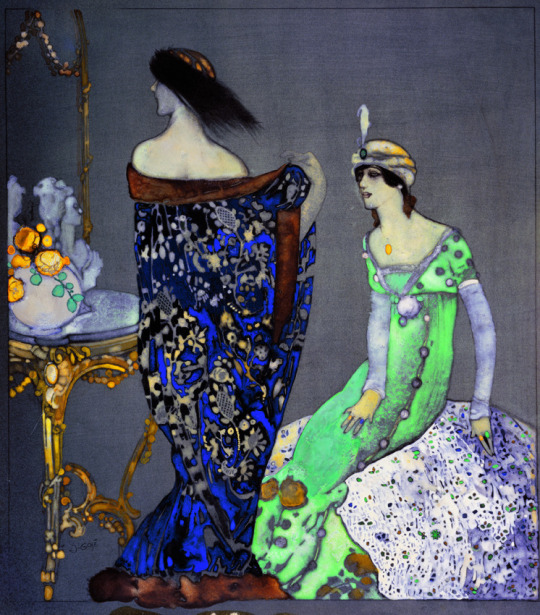
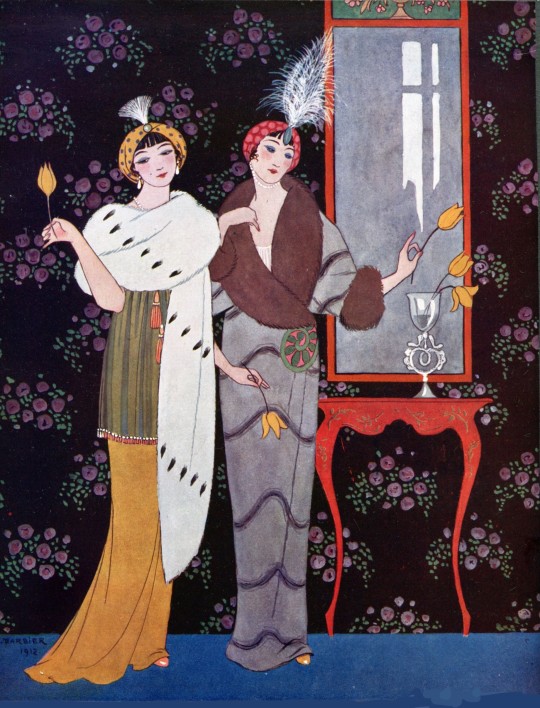
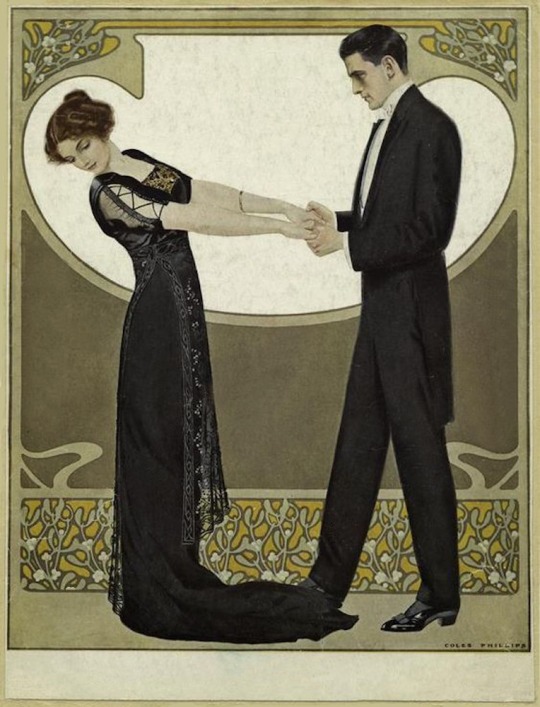
ca. 1912 a Femme chic, Supplément by A. Souchel (Rijksmuseum). From their Web site; fixed flaws & spots w Pshop 3229X5315.
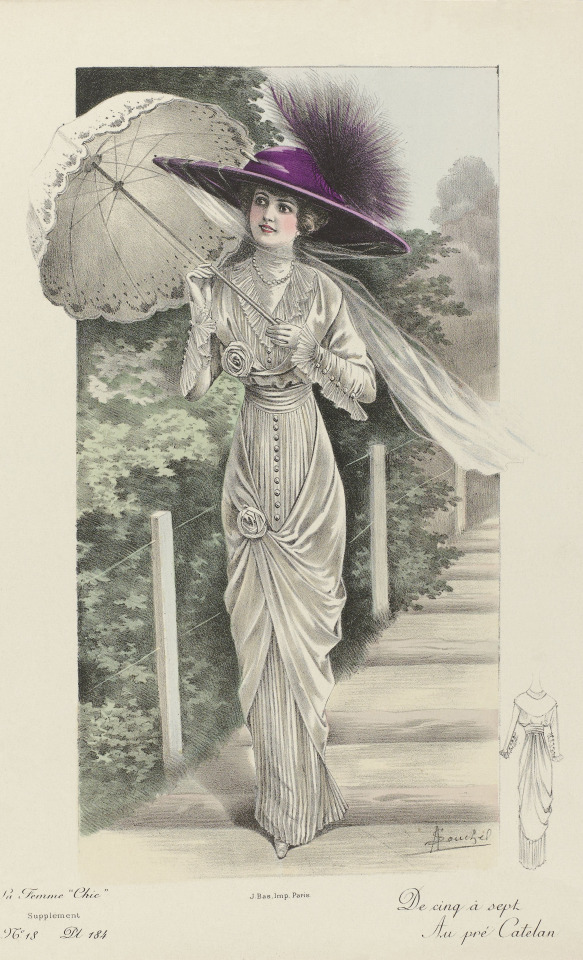
#1912 fashion#1910s fashion#Belle Époque fashion#Edwardian fashion#Lucile#Franz von Stuck#Mrs. J#Józef Męcina-Krzesz#Mrs. Ernest Guinness#Francis Bernard Dicksee#Mrs. John Lawrence#Edmund Tarbell#Princess Elena of Greece#Princess Paley#Worth#Vizcondesa de Termens#Jeanne Paquin#George Barbier#Marie Gabrielle in Bayern#F. Grainer#Olga de Meyer#Paul Poiret#Duchess of Portland Winifred#Philip Alexius de László#Xavier Gosé#Gash#Coles Phillips#A. Souchel#hobble skirt#parasol
34 notes
·
View notes
Text

Ernest & Celestine: A Trip to Gibberitia (2022, France)
Before the late 2000s and early 2010s in the United States, the possibility of finding mostly hand-drawn animated features from outside the major American studios and select anime works was a remote one if you did not live near a major city. Chipping away at that reality is New York City-based GKIDS, a distributor dedicating itself to introducing independent animation, “for both adult and family audiences.” Without GKIDS, Ireland’s Cartoon Saloon (2009’s The Secret of Kells, 2020’s Wolfwalkers) does not have the international reputation that it now has. GKIDS’ dedication to playing both dubbed and subbed versions of movies (before handing over theatrical distribution rights of Studio Ghibli movies to GKIDS, Walt Disney Studios only offered English dubs for theatrical releases) has shown its respect for its audiences.
When I saw Ernest and Celestine (2012, France/Belgium) in a theater in March 2014, it was the first GKIDS release I saw that was staunchly a children’s movie. What I saw that day was eye-opening. Here, like the animated movies that colored my younger days, was a work that could easily appeal to kids. But had similar, if not equal, appeal to adults. Call me a provincial and ethnocentric American all you will, but I realized then that non-English and non-Japanese-language animation is not always “more sophisticated” than what my friends and I mostly watched. It remains, to me, one of the best animated features of this young century. My thanks to GKIDS for all that they provide to American audiences willing to branch out beyond what is most readily available.
A decade and a CGI animated television series later, a new film based on the duo created by the late author-illustrator Gabrielle Vincent arrives. Based on an original story, Ernest & Celestine: A Trip to Gibberitia (in French: Ernest et Célestine: Le Voyage en Charabïe) retains the spirit of the loving friendship between bear and mouse – both perpetual outsiders. This hand-drawn sequel’s directors are Julien Chheng (animator on the original movie, producer of Primal, and director of “The Spy Dancer” from Star Wars: Visions) and Jean-Christophe Roger (a director on the TV series). There was no involvement from the original movie’s directors – I’m unsure what Stéphane Aubier and Vincent Patar (2009’s A Town Called Panic) are up to; Benjamin Renner is now working at Illumination. With some modifications that resemble more of the television series than the original film, Ernest & Celestine: A Trip to Gibberitia is another comedic delight, with pointed statements to make about the absurdity of government censorship. It does not exactly recapture the aesthetic pleasures nor the succinct writing of the first movie, but it still compares favorably than almost anything released in English-language animation this year.
Ernest and Celestine (Lambert Wilson and Pauline Brunner, both returning to the roles), defying societal expectations and a biased legal system in the first film, are still living together. Celestine draws and paints. Ernest, who has just awoken from hibernation, busks on his Stradibearius violin and bandoneon (it’s not an accordion). One day, Celestine accidentally breaks the neck of Ernest’s violin – Celestine is repentant, Ernest distraught but not angry. The only one who can fix the violin is the original craftsman, Octavius (Jean-Marc Pannetier). He lives in Ernest’s all-bear homeland of Gibberitia (Charabïe*), and Celestine believes that they should travel there immediately. A resistant Ernest opposes the plan, but has no choice to follow Celestine when she takes the violin and sets off to Gibberitia on her own. In the first film, Ernest mentions his estranged relationship with his family was due to the fact that he became a musician rather than go into law. In this sequel, Celestine learns the exact details of that conflict, and Ernest witnesses the changes in his family (his parents and especially his younger sister) and Gibberitian society that have transpired due to his decision.
Without spoiling too much, Gibberitia has outlawed all musical notes except for one (a C, or referring to solfège, “Do”). How are the average Gibberitian bears coping? All you have to do is look at the national slogan: “That’s just how it is.”‡ Meanwhile, a mysterious saxophonist vigilante named EFG (“Mifasol”, again referring to solfège) playing multiple-note music is giving the Gibberitian police a headache.
Screenwriters Guillaume Mautalent and Sébastien Oursel (the French-Irish animated TV series Glactick Football) present an endearing screenplay that captures the platonic love between bear and mouse. This happens in spite of a messy final act, headlined by a head-scratching decision from Ernest to acquiesce to his father’s demands just before the climax (the result of what the directors Chheng and Roger admit were significant changes to the story in order to accommodate a film where music helps to drive the narrative). The friendship that Ernest and Celestine built in the first film has grown in the time between the two films, and it is reassuring to see that they remain so close. One sees it in their reactions when Celestine breaks his violin, Ernest’s attempts to make sure Celestine is safe, her disgust when she hears about his parents’ expectations, and quieter moments where little else is happening. Simple as their friendship may seem, their relationship has deepened over time, through their distinct but complementary personalities and mutually weathered conflicts. Certainly, Ernest can be a bit of a grump and Celestine has an impulsive streak. But the two accept each other for who they are in that moment, and cannot stand the sight of others treating their friend without compassion. There is much for children to learn here and in the previous film, as well as adults.
That ability to tell a story appealing (in different ways) to both younger and older audiences is even apparent in the drama that exists alongside Ernest and Celestine’s relationship. Gibberitia’s decision to outlaw all but one musical note provides the bulk of this sequel’s comedy and dramatic intrigue. Children will get a kick out of the situation's silliness, as even Gibberitia’s songbirds find themselves on the receiving end of the police’s high-pressure hoses. How much laughter can one elicit from playing a piece, with a straight face, that has only one note? More than you think. Adults will quickly notice the surprisingly sharp critique towards government officials looking to censor works of art. Artists are incarcerated without trial for playing anything other than a C. That the reasons behind the decision are hilariously shallow (rather than, to take a real-life scenario, an intent to further marginalize marginalized groups) makes the movie’s messaging that much more effective for all audiences.
Ernest and Celestine’s conversations with the local constabulary are alarmingly fruitless, usually ending with the authority saying something alone the lines of: “because I said so” or the oft-quoted “that’s just how it is.” If Gibberitia’s kritarchy is outlawing all but one note, what else are they up to? Co-directors Chheng and Roger and co-writers Mautalent and Oursel, to ensure the film’s appeal to children, will not say and steadfastly stick to the ban on all but one musical note. In a show of respect to viewers of all ages, they color the film’s protagonists and their allies with both irreverence and a bold refusal to honor the status quo. It befits Ernest and Celestine (the pair and the prior film): two social outcasts who found friendship through art, who stuck together in the face of mutual xenophobia by their fellow bears and mice (a similar allegory that 2016’s Zootopia bungled). When individuals are allowed to be what they want, when musicians can play whichever notes they wish, does that not make our world – humans and sassy talking animals alike – richer and more beautiful?
Where the preceding television series Ernest and Celestine, the Collection was animated with computers, Chheng and Roger decided to return to hand-drawn animation for Ernest & Celestine: A Trip to Gibberitia. Says Roger in his non-native English:
There is a kind of emotion very, very specific to the drawing. It doesn't really work when it's CG. So we wanted to keep that kind of emotion, or very artistic part, as a part of the film itself. So that's why we came back to the animation, and we work in a specific way to give freedom to animators to express the feeling of the character just by their drawing and animation.
What I think Roger is attempting to say here is that, with a hand-drawn film, character expressions lead into the audiences’ emotional intuition better than computer-generated animation. There exists an expectation, implicit or not, that CGI animation should be “more realistic” than anything hand-drawn. This expectation does not exist with hand-drawn animation, and the rawness and immediacy of the craft lends to greater emotional engagement and work from the viewer. Chheng also added in that same interview that he did not want a “heavily rendered” work, and thought it appropriate to give their animators as much artistic freedom as possible while being respectful to the original illustrations by Gabrielle Vincent. The visible brushstrokes and various pencil scribbles call attention to the animators’ handiwork, and are a homage to those original Gabrielle Vincent illustrations.
Chheng and Roger make some changes in style from the first film. The watercolor style remains, but the white voids and intentionally incomplete exterior backgrounds are gone, with more detail packed into the frame for this sequel. Foregrounds, too are more detailed than before. These changes are probably due to the new setting of Gibberitia: a mishmash of Russian, Ukrainian, Moldovan, and Central Asian influences (Roger was particularly influenced by a trip he made through northern Pakistan into China). Gibberitia is eye-popping, a visual delight, and a more captivating animated production design than in the preceding movie.
youtube
Moreso than the preceding movie, the score drives much of the narrative. Vincent Courtois returns to compose another Ernest & Celestine film, and this is a more memorable outing than the first go. Courtois builds his score around two major themes – one that represents Gibberitia and another signifying the Musical Resistance (and a theme that often is heard from EFG’s saxophone). The best integration of both themes comes in “Appel à la resistance” – a zany combination of swinging saxophone and bandoneon. The Gibberitia theme, often heard with bandoneon and winds (and what may be ethnically appropriate strings), reflects the vaguely Eastern European or Central Asian setting of Ernest’s homeland. The chord progressions of the idea resemble Eastern European folk music (“Korobeiniki”, better known as the Tetris theme, perhaps the most popular). The eleven-note Musical Resistance motif (begins at 0:09 in previous link), is integrated throughout the score, slowly revealing itself and becoming more apparent as Ernest and Celestine learn more about the musical freedom fighters banding together to oppose Gibberitia’s nonsensical musical policy.
Courtois composed the score before any writing was complete. This is contrast to what usually happens in any and all filmmaking, where the score is usually one of the last things to complete. From there, Chheng and Roger crafted their film and set the action sequences to the rhythm and contours of Courtois’ music. Music drives the way in more ways than one in Ernest and Celestine: A Trip to Gibberitia, making the film not just a fun watch, but a wonderful listen (and that includes the end credits song “Qu-est-ce qu’on fait de l’amour?”, composed by Courtois and performed by Pomme).
Ernest and Celestine: A Trip to Gibberitia may not as accomplished as the first film, but this is a charming continuation of what came before. A decade separates the two Ernest and Celestine films. One hopes a third will not be so far away, but Chheng and Roger sound content to wait for the right reasons and story to come their way. Now undoubtedly each other’s best friend, Ernest and Celestine stake their claim as the premier odd couple of modern animated cinema. Celestine’s optimistic determination and Ernest’s streetwise know-how, together, help themselves and others. Free of cynicism, they continue to grow with each other, spreading the hallmarks of their unlikely friendship along the way.
My rating: 8/10
^ Based on my personal imdb rating. My interpretation of that ratings system can be found in the “Ratings system” page on my blog. Half-points are always rounded down.
* This review is based on the original French audio with English subtitles. "Charabïe" definitely does not sound like "Gibberitia", but the word is derived from "charabia", which is French for "gibberish". Ultimately, the decision for English title lies with the original studio(s), not non-domestic distributors like GKIDS.
‡ More accurately, the slogan is, "C'est comme ça et pas autrement." More literally, this means: "It's this way and only this way."
Also in this series: Ernest and Celestine (2012, France/Belgium)
#Ernest and Celestine#Ernest and Celestine: A Trip to Gibberitia#Ernest et Célestine: Le Voyage en Charabie#Julien Chheng#Jean-Christophe Roger#Gabrielle Vincent#Guillaume Mautalent#Sébastien Oursel#Lambert Wilson#Pauline Brunner#Vincent Courtois#Pomme#GKIDS#My Movie Odyssey#Youtube
8 notes
·
View notes
Text
How Every Character (Living) Dies, for @klqrambles
Utterson: Drinks himself to death, a year after the events of canon. Prior to the deaths of the two men closest to him, Utterson was known to like gin. It’s a given that he’d turn to it after his childhood friend and love of his life died in the worst possible circumstances. Unfortunately, the great sadness that consumed him grew too great for alcohol to soothe, though he damn tried. This ended up being his downfall, and he died of alcohol poisoning.
Maybe that was his end goal. Dying, finally able to see those who had left him behind?
Lord Henry: Wotton survived into relatively old age, and ended up dying of a heart attack fifteen years post canon. But he was alone. His antics had come back to bite him in the ass. Victoria was long gone; years of neglecting her needs causing their split. There was no longer a Basil to pretend he was not worried for his friend’s condition, there was no Dorian to lighten his spirits. All he had were the butlers he was relatively distant from.
He dies with the knowledge that it’s what he deserved.
Walton: After some twenty years at sea, Walton ended up— ironically— dying of pneumonia, the same ailment that had ended the life of the ever mysterious Victor Frankenstein. He was, at least, surrounded by his caring crew members.
Margaret outlived him, and ended up publishing his letters for the world to see.
Ernest: The second, only living Frankenstein brother lived to be old. He contracted and died of pancreatic cancer when he was near 80; however, he died surrounded by family, having lived a happy life.
Truly a pity his brother couldn’t have said the same.
#gothic lit#angst#long post#death and dying#alcoholism tw#jekyll and hyde#frankenstein#gabriel utterson#the picture of dorian gray#lord henry wotton#robert walton#ernest frankenstein
41 notes
·
View notes
Photo


That’s a wrap for the Charm household!
When I first began playing this family I didn’t feel as invested in them as I did with some of the other families. I’ve played a spellcaster before and found it super fun but this time something felt a bit off. Maybe it was the size of the household and that they are all spellcasters so there wasn’t much variety.
Could also be that I have not felt myself the last couple of weeks. Winter is kicking my butt with the sad’s and work has been a bit hectic as well. People sick with COVID and just general colds are doing the rounds which so far I’ve managed to avoid both.
Achievements under the cut. ;)
Darrel
Aspiration: Spellcraft & Sorcery - milestone #2
Career: Business - Assistant Manager L4
Skills: charisma 5
Spellcaster Rank: Adept 4
Emilia
Aspiration: Spellcraft & Sorcery - milestone #2
Career: Culinary - Juice Boss L7
Skills: cooking 5, mixology 5, violin 5
Spellcaster Rank: Acolyte 3
Gabriel
Aspiration:
Career:
Skills: imagination 4, movement 4, thinking 4
Gemma
Aspiration: Spellcraft & Sorcery - milestone #2, Purveyor of Potions - milestone #3
School: grade A
Skills: mischief 5
Spellcaster Rank: Adept 4
34 notes
·
View notes
Photo
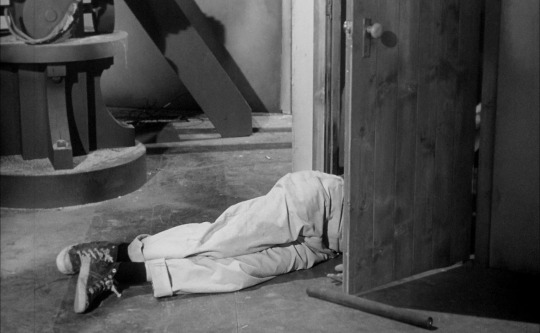




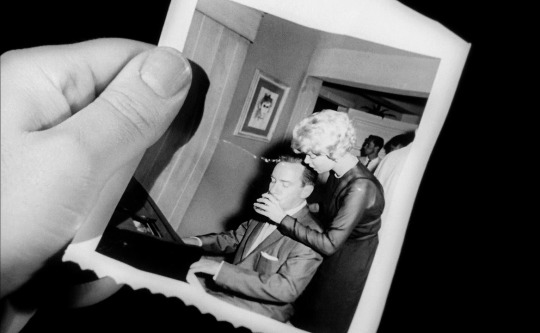


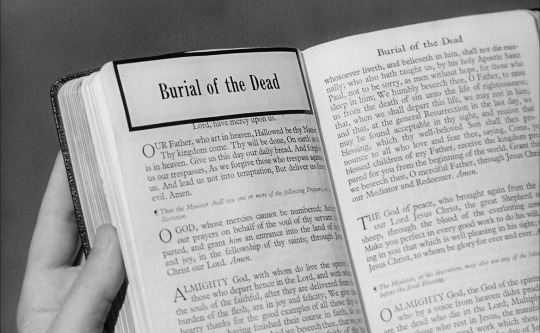

Tormented (Bert I. Gordon, 1960).
#tormented#tormented (1960)#bert i. gordon#susan gordon#richard carlson#juli reding#ernest laszlo#john a. bushelman#gabriel scognamillo#gene redd#herman e. townsley#flora m. gordon
35 notes
·
View notes
Photo
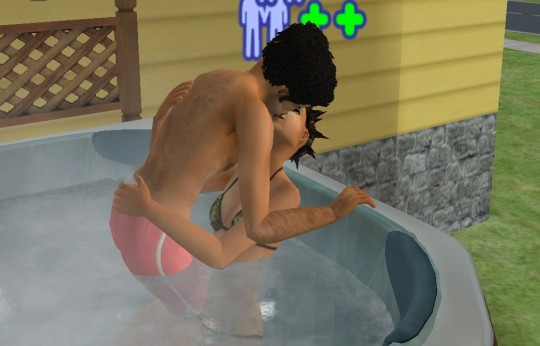
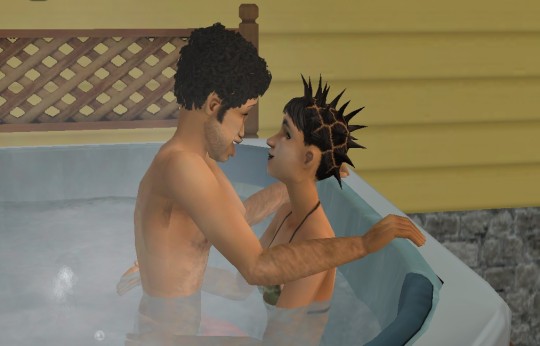



Frat, Day 82, Part 3
Ernie brought Les home and they woohooed in the hot tub and the car before the date timer ran out.
Theo, meanwhile, spent his morning playing pinball and not getting dressed.
4 notes
·
View notes
Text
Of Dreams And Open Doors - LadyMorgaine76 - Ginga Eiyuu Densetsu | Legend of the Galactic Heroes [Archive of Our Own]





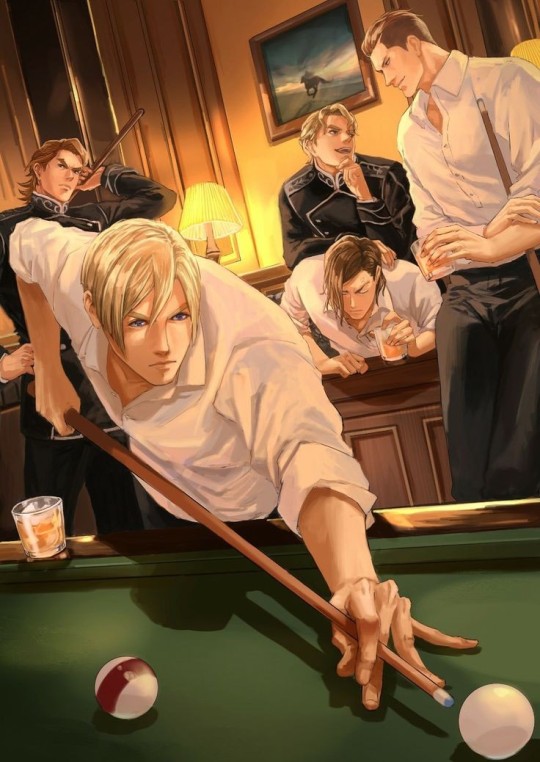

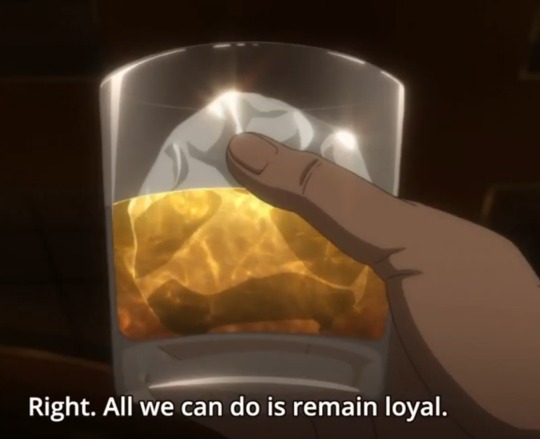
#legend of the galactic heroes#logh#ginga eiyuu densetsu#die neue these#and my fanfic stuff#oskar von reuenthal#wolfgang mittermeyer#Gabrielle Brüner#siegfried kircheis#reinhard von lohengramm#ernest mecklinger#august samuel wahlen#cornelius lutz#fritz josef bittenfeld#karl gustav kempf
2 notes
·
View notes
Text
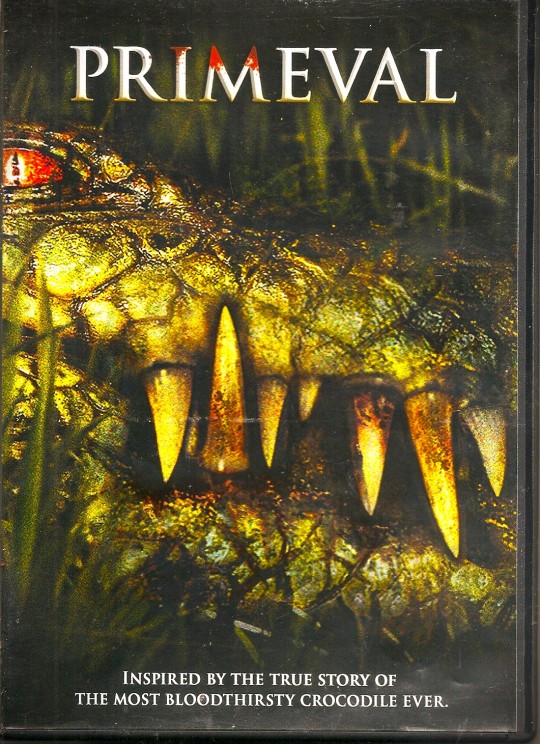
Bad movie I have Primeval
#Primeval#Dominic Purcell#Brooke Langton#Orlando Jones#Jürgen Prochnow#Gideon Emery#Gabriel Malema#Linda Mpondo#Lehlohonolo Makoko#Dumisani Mbebe#Eddy 'Big Eddy' Bekombo#Chris April#Ernest Ndlovu#Erica Wessels#Vivian Moodley#Lika Berning#Andrew Whaley#Patrick Lyster#Jaqui Pickering#Kent Shocknek#Mathias Tabotmbi#Kgmotoso Motlosi#Thandi Nugbani#Michael Mabizela#Thomas Kariuki#Azeez Danmola#Pamphile Nicaye#Emmanuel Nkeshiman#Pierre Calver Nsabimana#Henry Jeane
0 notes
Text






















taylor swift lyrics x colors x textiles in art – red
Fifteen – Fearless // Augusta of Bavaria with Her Children – Andrea Appiani ❤️ Love Story – Fearless // Portrait of a Prussian Prince – Unknown Artist ❤️ Red – Red // Apples – Kuzma Petrov-Vodkin ❤️ All Too Well – Red // Birdsong – Károly Ferenczy ❤️ All Too Well – Red // Portrait of a Lady – John Opie ❤️ The Moment I Knew – Red // Portrait of Sophia Hedwig of Brunswick-Lüneburg – attributed to Wybrand de Geest ❤️ Nothing New – Red // Sibylla Palmifera – Dante Gabriel Rossetti ❤️ Blank Space – 1989 // Tomaž Hren – unknown artist ❤️ Style – 1989 // Ernest Amadej Tomaž Attems – unknown artist ❤️ Wildest Dreams – 1989 // A Vision of Fiametta – Dante Gabriel Rossetti ❤️ New Romantics – 1989 // Portrait of Armand Gaston Maximilien de Rohan – Hyacinthe Rigaud ❤️ End Game – Reputation // A Genoese Lady with Her Child – Anthony van Dyck ❤️ I Did Something Bad – Reputation // Marie-Adélaïde de France – Johann Julius Heinsius ❤️ Look What You Made Me Do – Reputation // Infanta Isabel of Spain – Carlos Luis de Ribera y Fieve ❤️ Daylight – Lover // Self-Portrait – Gwen John ❤️ the lakes – folklore // Maria Amalia of Saxony – Anton Raphael Mengs ❤️ gold rush – evermore // Barine – Edward Poynter ❤️ Maroon – Midnights // Margaret “Peg” Woffington – unknown artist ❤️ Maroon – Midnights // Portrait of Marchessa Marianna Florenzi – Joseph Karl Stieler ❤️ Maroon – Midnights // Henry IV, King of France in Armor – Frans Pourbus the Younger ❤️ Maroon – Midnights // Elizabeth I as a Princess – attributed to William Scrots ❤️ The Great War – Midnights // Augusta, Duchess of Cambridge with Her Children – Melchior Gommar Tieleman
#fearless#fearless taylor swift#red#red taylor swift#red taylor’s version#1989#1989 taylor swift#reputation#reputation taylor swift#lover album#lover taylor swift#folklore#folklore album#folklore taylor swift#folklore ts#evermore taylor swift#evermore ts#evermore#evermore album#midnights#midnights album#taylor swift midnights#midnights taylor swift#taylor swift#long post#taylor swift lyrics x colors x textiles in art
130 notes
·
View notes
Text
Thoughts on Drinks in S2
Updated 10 Nov 2023
I thought I might put together some of my rambling thoughts on all the drinks that appear in S2 in general, since there are far more of them than food. I believe the hot chocolate is just as important as the coffee choices and some just make interesting comments.


Tea
Tea only makes a brief appearance, notably when Muriel visits the bookshop and meets Azriaphale. It is an introduction to the ways of humans. The only other tea we see are the offered herbal teas of peppermint (stimulating) or chamomile (a relaxant) to Maggie by Nina, and we don't know which one Maggie chooses.


Sherry
The request for sherry in the pub is, quite simply, hilarious, even without the Lady Bracknell ad lib. In Australia, where I am from, and I believe the UK as well, sherry has a long tradition as a ladies drink. And one wouldn't be adverse to have a nip or two (or more) while doing the cooking with it. If you haven't seen The Importance of Being Ernest performed, not just read it, you really must make the effort. (Coincidentally, I was taken as a teenager to see a version where Lady Bracknell was played for comedic effect by a man in drag. I loved it, and have never forgotten it, or the cucumber sandwiches.)
Wine
In S2E1 we have Nina reaching for the comfort wine while trapped in the coffee shop. She offers Maggie some, but she declines, and offers "No judgement."
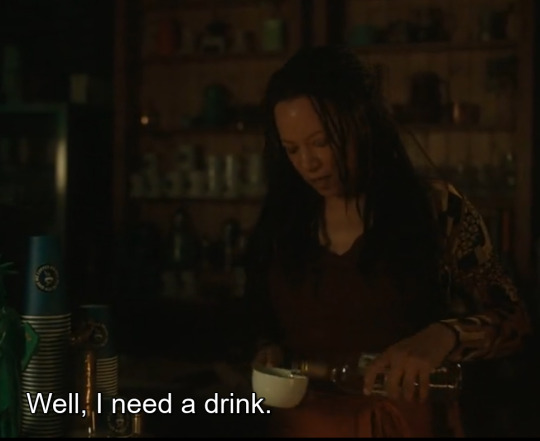

Then we have some romantic wine in 1941, and some potentially romantic wine back in the present. Or is it?


Why don't you just talk to Gabriel, suggests Aziraphale. Alright, I will! declares Crowley, pausing only to take the wine bottle with him. The next thing we see is him ready to pass his Judgement on the amnesiac archangel.


Edit: I missed quite a bit of wine my first time around! There was two lots of wine in the Job minisode, and that was quite judgemental as well.
What, you didn't bring the wine, angel?

Then later in the cellar, while the storm rages, Crowley does find some wine and proceeds to enjoy the fruits of his demonic work while having a moral argument with Aziraphale.
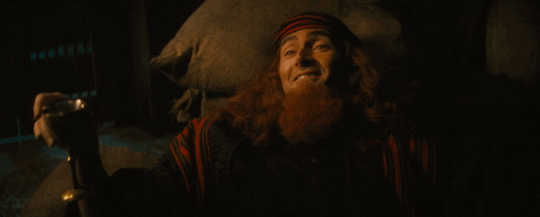
Hot Chocolate
Ah! Ohohoh! The hot chocolate! Jim-short-for-James hot chocolate! I think it is very telling he is offered it by both Aziraphale and Crowley. The first gif sees him drinking while overlooking the Outside and a reflection of "give me coffee" in the window (this is the start of S2E3.) He is walking a different road to the others, one protected and facilitated by A & C. The coffee isn't for him, its for Other People. He gets his own special stash of the Good Stuff, labeled and everything. Privilege for the Frog Prince, sheesh.
Edit: Several times I've tried to explain the Choice of the Hot Chocolate, and I've actually replied to someone here about it in the mean time in a way that I'm happy with - here is most it, below:
Most of us get the two options, coffee, or death.
But Jim has been given a third option, and he has grabbed it enthusiastically with both hands. Aziraphale has handed it to him in spades, even! That much will take a long time to get through, wouldn't it. It's a big generous gift, that Aziraphale understands well. Gabriel came to Aziraphale because he instinctively knew Aziraphale understood what he needed.
Mr 'six-shots-of-espresso' loves his freedom, or liberty, and his life here on Earth. The humans who line up for their dose of Heaven every day do, too.
Death is the option-that-is-not-an-option. It's duty. It's the tax we all have to pay for living.
So the Metatron turns up and offers Aziraphale a coffee to one who doesn't drink coffee. Essentially the Metatrash offers a choice that isn't a choice. Aziraphale's only choice is to do his duty at this point, or else...well, we aren't shown it, but it seems the 'else' was too terrible to contemplate. (Or, as some people alternatively see it, the Metatron kept pushing until he was offered a carrot he couldn't refuse.)
But Jim, he's been give the option that Aziraphale and Crowley really want, but can't quite have at this point. Freedom to love as they want, and openly in front of all Heaven, Hell and Humanity. They understand. They don't judge Jimbriel for this, they actually encourage it - they both make it happen right under the Ineffable Bureaucracy's noses in the end! The irony of it! They give their arch-enemy the gift that they dream of.
I'm very tempted to digress off into a discussion about the two glimpses of authority we get from Crowley and Aziraphale in S2E6 at this point (Crowley yelling at the demons prior to the attack on the shop, and Aziraphale shouting at the Ineffable Bureaucracy representatives arguing what to do about Gabe and Beez in the shop to shut up,) and what it might it might tell us about their pasts. Because, as others have noted, Gabriel and Beelzebub have that freedom to be together in front of everyone because they have power - they are essentially the top ranking beings in this AU. They can do what they want with little fear of consequences. And I guess the Metatron didn't step in to intercede at this point because he essentially wanted Gabriel gone from the picture, and this was a convenient way to do it.
So yeah, the sweet hot chocolate is Gabriel's special option, facilitated by Aziraphale and Crowley. He doesn't have to drink what the plebs drink, the bitter devotional duty to Heaven.
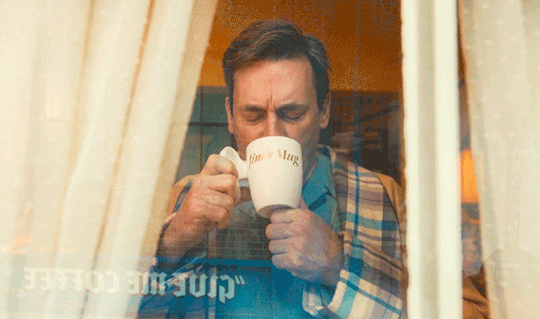

Whiskey
The demon drink. Fire water. (Maybe...enough said? Not sure...I've got dots to spare here...fire...and water...hmm...where have we seen that before...)


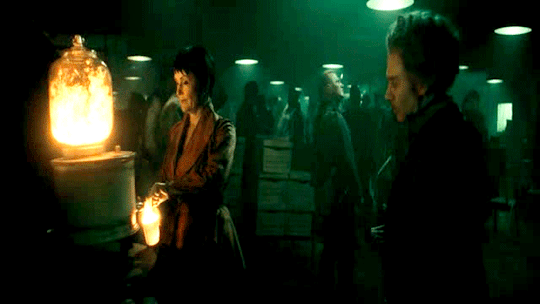
Coffee
Give Me liberty Coffee, or Give Me Death!
Six shots of espresso in a big cup for Crowley - lots of freedom for the demon.
The humans line up every day to get their ration of free will.
Regarding the Metatron's coffee offer to Aziraphale, the best explanation I've seen of it is here. The almond syrup signals that Aziraphale is being watched, and to me he is being offered a choice he can't refuse. He has no option but to accept it. In regards to the oat milk, I've seen a suggestion that it was a reference to Aziraphale being too free while on Earth and having a chance to "sow his oats." Also the purpose of offering it was to see if he was compliant enough to follow orders when asked.


Coffee shops have historically been a hotbed of foment, where new ideas were discussed, business conducted and rebellions started.
Finally there's a special mention for Gabriel and Beelzebub with their "intoxicating liquor."

Which they didn't. They got to make their own choice, in the end, thanks to Aziraphale.
Extra edit:
The Laudanum
I originally didn't include this one, but since posting this I realised how it fits in. I've written it up in this meta here - The Altar of Eccles Cakes, - because its a Sin Offering.
[A Sin Offering was for] atonement or unintentional sin. It would have the elements of a Burnt offering, as well as a Peace offering, but not be shared.
It pretty clear to most observers that Crowley did a good and "kind deed" for Elspeth here, which angered Hell in the process and then he was dragged forcibly downstairs to be duly punished for it. There is a post here from atlas-hope that suggests this is a parallel of Jesus in the Garden of Gethsemane, drinking the cup of God's wrath to absolve Christians of their sins. They point out the laudanum is even poured into a goblet. Crumbs, that's a hefty bit of spiritual lifting, dear demon. What were you thinking, Anthony J. Crowley? It might cast that conversation you had with the carpenter back on the mountain in a new light, or least make us look back twice at it. (Plenty of time for contemplation before S3 arrives...)
Remember, a Sin offering has elements of both a Burnt offering and a Peace offering: a giant Crowley gets Elspeth to promise to devote the rest of her life to being "properly good, not just pretendy good" and the money Aziraphale is forced to donate to her ensures her future prosperity. Sounds like a win-win situation there, Elspeth!

#gos2#good omens meta#good omens analysis#good omens s2#aziraphale#crowley#Gabriel#Jim short for Gabriel#Nina and Maggie#Lady Bracknell#sherry#whiskey#6 shots of espresso nothing else#coffee theory#coffee shop#the pub#fire water#almond syrup#shax#furfur#cupperty#no judgement
102 notes
·
View notes
Text
Biographical movies and dramas about writers:
Tolkien (2019) - about JRR Tolkien
The Edge of Love (2008) - about Dylan Thomas
Set Fire to the Stars (2014) - about Dylan Thomas
Colette (2018) - about Sidonie-Gabrielle Colette
Wilde (1997) - about Oscar Wilde
The Trials of Oscar Wilde (1960) - about Oscar Wilde
My Salinger Year (2020) - about JD Salinger
Rebel in the Rye (2017) - about JD Salinger
Mary Shelley (2017) - about Mary Wollstonecraft Shelley
Gothic (1986) - about Mary Wollstonecraft Shelley
Shakespeare in Love (1998) - about William Shakespeare
Sylvia (2003) - about Sylvia Plath
Dickinson (2019-2021) - about Emily Dickinson
A Quiet Passion (2016) - about Emily Dickinson
Vita & Virginia (2019) - about Virginia Woolf
Becoming Jane (2008) - about Jane Austen
Miss Austen Regrets (2007) - about Jane Austen
Kafka (1991) - about Franz Kafka
Byron (2003) - about Lord Byron
Total Eclipse (1995) - about Paul Verlaine
Capote (2005) - about Truman Capote
Rowing with the Wind (1988) - about the Romantic Poets
Infamous (2006) - about Truman Capote
Quills (2000) - about Marquis de Sade
Neruda (2016) - about Pablo Neruda
Juana Inés (2016) - about Sor Juana Inés de la Cruz
Daphne (2007) - about Daphne du Maurier
Priest of Love (1981) - about DH Lawrence
Little Ashes (2008) - about Federico Garcia Lorca
Lope (2010) - about Lope de Vega
Howl (2010) - about Allen Ginsberg
The Last Station (2009) - about Leo Tolstoy
Young Goethe in Love (2010) - about Johann Goethe
Tom & Viv (1994) - about T.S. Eliot
Céleste (1980) - about Marcel Proust
Hemingway & Gellhorn (2012) - about Ernest Hemingway
Balzac: A Life of Passion (1999) - about Honore de Balzac
The Man Who Invented Christmas (2017) - about Charles Dickens
Shirley (2020) - about Shirley Jackson
Goodbye Christopher Robin (2017) - about Alan Alexander Milne
Heart Beat (1980) - about Jack Kerouac
In the Heart of the Sea (2015) - about Herman Melville
Notes: Not all of the films on this non-exhaustive list are entirely “about” the lives of their respective writers to a tee. I cannot vouch for the accuracy or quality of all of these movies. I’ve only seen about 75% of these films personally. And yes, I know this list is very Westernized – I’m working on it.
#if any kind person wants to make a letterboxd list with these#be my guest and send me the link as well por favor so i can save it#period drama#period film#films#movies#filmblr#film blog#movieblr#movie blog#letterboxd#mary shelley#oscar wilde#emily dickinson#jrr tolkien#poetry#poets#biopic#film recs#film recommendations#movie rec list#historical fiction#historical drama#dark academia#dark academia aesthetic#favourite movies#film student#jd salinger#dylan thomas#truman capote
24 notes
·
View notes
Text
GOTHLIT SEXYMAN BRACKET (FINAL UPDATE WITH WINNERS!)

Congrats to the winner, Mr. JONATHAN HARKER!
More below cut :)
BONUS POLL WINNERS:
Edward Hyde (Jekyll & Hyde) vs. Frankenstein's Creature (Frankenstein)
Ernest Frankenstein (Frankenstein) vs. Poole (Jekyll & Hyde) vs. Alan Campbell (Picture of Dorian Gray) vs. R.M. Rendfield (Dracula)
-----------------------------------------------
Thank you all for voting in the Gothlit Sexyman Contest! We will always appreciate all the good times had here, and will never forget the sacred battle that was fought here.
If you would like more, go follow and vote in the @gothlit-sexywoman-contest (starting now!)
----------------------------------------------
FINAL RANKINGS:
Jonathan Harker (Dracula)
2. Griffin/the Invisible Man (The Invisible Man)
3. Quincey Morris (Dracula)
4. Basil Hallward (The Picture of Dorian Gray)
5. Victor Frankenstein (Frankenstein)
6. Dorian Gray (The Picture of Dorian Gray)
7. Arthur Holmwood (Dracula)
8. Henry Clerval (Frankenstein)
9. Jack Seward (Dracula)
10. Gabriel Utterson (The Strange Case of Dr Jekyll & Mr Hyde)
11. Erik/The Phantom (The Phantom of the Opera)
12. Henry Wotton (The Picture of Dorian Gray)
13. Henry Jekyll (The Strange Case of Dr Jekyll & Mr Hyde)
14. Sydney Carton (A Tale of Two Cities)
15. Robert Walton (Frankenstein)
16. Charles Darnay (A Tale of Two Cities)
#goth lit#gothlit sexyman contest#polls#a tale of two cities#the strange case of dr jekyll and mr hyde#the phantom of the opera#the invisible man#the picture of dorian gray#dracula#frankenstein
196 notes
·
View notes
Text
How many of these "Top 100 Books to Read" have you read?
(633) 1984 - George Orwell
(616) The Great Gatsby - F. Scott Fitzgerald
(613) The Catcher In The Rye - J.D. Salinger
(573) Crime And Punishment - Fyodor Dostoyevsky
(550) Catch-22 - Joseph Heller
(549) The Adventures Of Tom And Huck - Series - Mark Twain
(538) Moby-Dick - Herman Melville
(534) One Hundred Years Of Solitude - Gabriel Garcia Marquez
(527) To Kill A Mockingbird - Harper Lee
(521) The Grapes Of Wrath - John Steinbeck
(521) Lolita - Vladimir Nabokov
(492) Pride And Prejudice - Jane Austen
(489) The Lord Of The Rings - Series - J.R.R. Tolkien
(488) Brave New World - Aldous Huxley
(480) Ulysses - James Joyce
(471) Jane Eyre - Charlotte Bronte
(459) Wuthering Heights - Emily Bronte
(398) The Brothers Karamazov - Fyodor Dostoyevsky
(396) Great Expectations - Charles Dickens
(395) To The Lighthouse - Virginia Woolf
(382) War And Peace - Leo Tolstoy
(382) The Sun Also Rises - Ernest Hemingway
(380) The Sound And The Fury - William Faulkner
(378) Alice's Adventures In Wonderland - Series - Lewis Carroll
(359) Frankenstein - Mary Wollstonecraft Shelley
(353) Heart Of Darkness - Joseph Conrad
(352) Middlemarch - George Eliot
(348) Animal Farm - George Orwell
(346) Don Quixote - Miguel de Cervantes Saavedra
(334) Slaughterhouse-Five - Kurt Vonnegut
(325) Les Misérables - Victor Hugo
(320) Harry Potter - Series - J.K. Rowling
(320) The Chronicles Of Narnia - Series - C.S. Lewis
(317) Anna Karenina - Leo Tolstoy
(308) Lord Of The Flies - William Golding
(306) Invisible Man - Ralph Ellison
(289) The Golden Bowl - Henry James
(276) Pale Fire - Vladimir Nabokov
(266) Gone With The Wind - Margaret Mitchell
(260) The Count Of Monte Cristo - Alexandre Dumas
(255) The Hitchhiker's Guide To The Galaxy - Series - Douglas Adams
(252) The Life And Opinions Of Tristram Shandy, Gentleman - Laurence Sterne
(244) Madame Bovary - Gustave Flaubert
(237) Vanity Fair - William Makepeace Thackery
(235) The Trial - Franz Kafka
(233) Absalom, Absalom! - William Faulkner
(232) The Call Of The Wild - Jack London
(232) Emma - Jane Austen
(229) Beloved - Toni Morrison
(228) Little Women - Louisa May Alcott
(224) A Passage To India - E.M. Forster
(215) Dune - Frank Herbert
(215) A Portrait Of The Artist As A Young Man - James Joyce
(212) The Stranger - Albert Camus
(209) One Flew Over The Cuckoo's Nest - Ken Kesey
(209) The Idiot - Fyodor Dostoyevsky
(206) Dracula - Bram Stoker
(205) The Picture Of Dorian Gray - Oscar Wilde
(197) A Confederacy Of Dunces - John Kennedy Toole
(193) Mrs. Dalloway - Virginia Woolf
(193) The Age Of Innocence - Edith Wharton
(193) The History Of Tom Jones, A Foundling - Henry Fielding
(192) Under The Volcano - Malcolm Lowry
(190) The Odyssey - Homer
(189) Gulliver's Travels - Jonathan Swift
(188) In Search Of Lost Time - Marcel Proust
(186) Midnight's Children - Salman Rushdie
(185) An American Tragedy - Theodore Dreiser
(182) The Book Thief - Markus Zusak
(180) Siddhartha - Hermann Hesse
(179) The Magic Mountain - Thomas Mann
(178) Things Fall Apart - Chinua Achebe
(178) Tropic Of Cancer - Henry Miller
(176) The Outsiders - S.E. Hinton
(176) On The Road - Jack Kerouac
(175) The Little Prince - Antoine de Saint-Exupery
(173) The Giver - Lois Lowry
(172) Brideshead Revisited - Evelyn Waugh
(172) A Clockwork Orange - Anthony Burgess
(171) Charlotte's Web - E.B. White
(171) The Ambassadors - Henry James
(170) Infinite Jest - David Foster Wallace
(167) The Complete Stories And Poems - Edgar Allen Poe
(166) Ender's Saga - Series - Orson Scott Card
(165) In Cold Blood - Truman Capote
(164) The Wings Of The Dove - Henry James
(163) The Adventures Of Augie March - Saul Bellow
(162) As I Lay Dying - William Faulkner
(161) The Hunger Games - Series - Suzanne Collins
(158) Anne Of Greene Gables - L.M. Montgomery
(157) Atlas Shrugged - Ayn Rand
(157) Neuromancer - William Gibson
(156) The Help - Kathryn Stockett
(156) A Song Of Ice And Fire - George R.R. Martin
(155) The Good Soldier - Ford Madox Ford
(154) The Da Vinci Code - Dan Brown
(153) I, Claudius - Robert Graves
(152) Wide Sargasso Sea - Jean Rhys
(151) The Portrait Of A Lady - Henry James
(150) The Death Of The Heart - Elizabeth Bowen
#books#book lists#p#im posting this so i can reblog it with my own crossed out list and i encourage others to do the same if you want to#i dont actually know how many ive read yet myself
20 notes
·
View notes
Photo

Star Wars: Visions volume 2 will stream on Disney+ on May 4, 2023.
Volume 2 shorts:
Title: “Sith”
Studio: El Guiri
Writer-director: Rodrigo Blaas
Rodrigo Blaas is an Emmy Award®-winning director who has spent more than 20 years in animation. After co-founding Stromboli Animation in 1997, Blaas joined Blue Sky Studios in 2000, working on the feature film Ice Age, before transitioning to Pixar Animation Studios. There, he worked on such projects as Finding Nemo (2003), The Incredibles (2004), Ratatouille (2007), and Wall-E (2008) and on the Oscar®-nominated short film La Luna (2011). More recently, Blaas partnered with Guillermo del Toro to develop the award-winning series Trollhunters, served as creative director for Mikros Animation Paris and, in 2021, created El Guiri Studios in Madrid with his partner, Cecile Hokes. He also wrote and directed 2009’s award-winning short film Alma.
Title: “Screecher’s Reach”
Studio: Cartoon Saloon
Director: Paul Young
Paul Young is a co-founder of Cartoon Saloon, an IFTA winner and Oscar®, Emmy® and BAFTA nominee. He produced the animated features My Father’s Dragon, WolfWalkers, The Secret of Kells, Song of the Sea, and The Breadwinner as well as award-winning TV series including Puffin Rock, Dorg Van Dango, and Viking Skool.
Title: “In the Stars”
Studio: Punkrobot
Writer-director: Gabriel Osorio
Gabriel Osorio majored in Fine Arts at Universidad de Chile, later specializing in 3D animation. After working in commercials, movies and television series, he founded Punkrobot Studio. Since 2008, he has directed projects for children’s television including Flipos, Muelin y Perlita, Soccer Girls, and television spots. In 2016, his short film Bear Story became the first Latin American project to win an Oscar® in the animated short category.
Title: “I Am Your Mother”
Studio: Aardman
Director: Magdalena Osinska
Magdalena Osinska is an award-winning director who has been with Aardman for eight years. She has directed stop-motion, CGI, 2D and live-action commercials including Wallace & Gromit’s “The Great Sofa Caper” and “Share the Orange.” Osinska directed development of the children’s series Joyets and has also directed films including Spirits of the Piano and Zbigniev’s Cupboard. A graduate of the National Film and Television School in Beaconsfield, UK, as well as the Polish Film School in Lodz and Art College in Warsaw, Osinska is currently developing the feature film Jasia, based on her grandmother’s memories of WWII Poland.
Title: “Journey to the Dark Head”
Studio: Studio Mir
Director: Hyeong Geun Park
Rising star Hyeong Geun Park had already made a name for himself when he entered the Korean animation industry in 2017, thanks to his strong drawing and animation sensibilities. He has directed animation for dozens of cinematic game trailers and has since expanded into animated series, working on projects including Dota: Dragon’s Blood: Book 3 (2022) and Lookism (2022). Journey to the Dark Head is the first title he has executive produced from start to finish.
Title: “The Spy Dancer”
Studio: Studio La Cachette
Writer-director: Julien Chheng
Julien Chheng is CEO of Studio La Cachette, an Emmy Award®-winning French animation studio he co-founded in 2014 with fellow Gobelins school’s alumni Oussama Bouacheria and Ulysse Malassagne. Chheng was trained in visual development at Disney and has worked as a character animator on acclaimed 2D animated features The Rabbi’s Cat, Mune, and the Academy Award®-nominated Ernest and Celestine. In 2021, he won an Emmy Award® as animation executive producer of Genndy Tartakovsky’s Primal, for which he also served as animation supervisor. In 2022, Chheng directed with Jean-Christophe Roger the Cesar-nominated feature Ernest and Celestine: A Trip to Gibberitia.
Title: “The Bandits of Golak”
Studio: 88 Pictures
Director: Ishan Shukla
Ishan Shukla started his career as a CG artist in Singapore. For more than a decade, he spearheaded projects ranging from TV commercials to series and music videos. His 2016 animated short, "Schirkoa," was long listed for the Academy Awards® after receiving dozens of awards and playing at 120 international festivals, including SIGGRAPH Asia where it was named Best in Show. He then set up his own animation studio to work on adult-oriented animated feature films including a feature-length version of Schirkoa, set to hit festivals in summer 2023.
Title: “The Pit”
Studios: D’art Shtajio and Lucasfilm Ltd.
Writer-director-executive producer: LeAndre Thomas
Co-director: Justin Ridge
LeAndre Thomas is an award-winning writer and director from Oakland, Calif., whose most recent film won Best Director at the Pasadena International Film Festival. In addition to his independent films, Thomas is a part of the franchise studio team at Lucasfilm Ltd. where he has worked for more than 11 years being credited on recent titles such as Light & Magic, The Mandalorian, Obi-Wan Kenobi, Star Wars: Tales of the Jedi, and many more.
Justin Ridge executive produced the Emmy®-nominated series Star Wars Resistance. His credits also include Star Wars Rebels, Storks, The Cleveland Show, Star Wars: The Clone Wars, and Avatar: The Last Airbender.
Title: “Aau’s Song”
Studio: Triggerfish
Writer-directors: Nadia Darries and Daniel Clarke
Nadia Darries is a director, animator and co-founder of Goon Valley Animation, with an avocation for songwriting. Born in the Cape Flats in South Africa, Darries has worked on high-end animated film and motion design as an animator, project manager, creative director and director since 2015. Her experience includes animating at Triggerfish Animation Studios on the award-winning BBC films Stick Man, Revolting Rhymes, and Highway Rat.
Daniel Clarke is a Cape Town-based director and artist working in animation, film and illustration. He started his career in animation in 2008 at Triggerfish Animation Studios, where he has served as production designer, art director and director on projects such as the feature film Khumba, BBC’s Stick Man, and The Snail and the Whale. In 2018, along with James Clarke and Daniel Snaddon, he completed the graphic novel Kariba.
#Star Wars Visions#SW Visions#Star Wars#El Guiri#Cartoon Saloon#Punkrobot#Aardman Animations#Studio Mir#Studio La Cachette#88 Pictures#D’art Shtajio#Triggerfish#Lucasfilm#Disney#Disney Plus#Disney+#television#cartoon#shorts#animated shorts#anime#anime shorts
182 notes
·
View notes